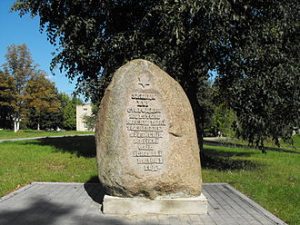Lida
 A town in Grodno Oblast, Belarus.
A town in Grodno Oblast, Belarus.
According to a decision of the Lithuanian council of 1623, the Jewish community of Lida was subordinated to the Grodno Kahal. The files of the Lithuanian financial commission contain records of the quarrels between the Lida Kahal and the Jews of the neighboring villages. In 1766 there were 1,167 Jewish-Pole tax payers in Lida and the vicinity. The community numbered 567 (73.6% of he total population) in 1817; 1,980 in 1847; 5,166 (68%) in 1897, when there were 24,813 Jews (12%) in the whole district; and 5,419 (40.4%) in the town, with 16.551 (8.5%) in the district in 1921. In the 1880s the 13 prayer houses in the town were grouped in one large square. They were all damaged in a fire. Until world war II the Butcher's synagogue contained an ark with undamaged ancient doors. In 1921, there were 302 Jewish workshops in Lida, over half of them family enterprises. There were 37 Jewish farms in 1927. Between the two world wars the community maintained a secular elementary school and a children's home, both affiliated to the central Yiddish school organization. There was also a Tarbut school. Among rabbis of Lida were R. David B. Aryeh Leib of Lida (later in Amsterdam), his son Pethahiah, and his grandson, the Tzaddik David Benjamin. R.Elijah Schick (Elinke Lider) officiated in the 19th century, and I.J. Reines, the Mizrachi leader, at the beginning of the 20th century. The latter founded a modern yeshivah in Lida which functioned until world war I. In 1940 the number of Jews in Lida had risen to 15,000.
During the period of Soviet rule (1939-41), Jewish community institutions were closed, the activities of Jewish parties was forbidden and the basis of the Jewish economy from the prewar period was demolished. A large part of the Jewish refugees from Western Poland who found shelter in Lida were deported to the Soviet interior in the summer of 1940. Groups of deportees were brought to Soviet camps in the Rybinsk area. With the outbreak of the war between Germany and the U.S.S.R. (June 22, 1941), the Germans bombed Lida; the centre of the town, which was inhabited principally by Jews, was burned, and there were hundreds of Jewish casualties. On July 5, 1941, the Germans collected the Jews of the city in the main square and took away all the Rabbis, shochatim, doctors and teachers-the leadership of the community – to near the village of Stoniewicze where they were murdered; 200 men fell at that time. In the autumn of 1941 the Jews were concentrated in a special square and were joined by the Jews from Lipniszki, Juraciszki, Traby and Duoly. On May 8, 1942, an Aktion was carried out. Only 1,250 people were left; all the rest were killed near the village of Stoniewicze. About 200 people succeeded in escaping the scene of the slaughter, returned to the ghetto, and told of the Germans' horrifying acts. A group of youths succeeded in leaving the city on May 21, 1942 and entered the forests of Naliboki. The youth in the ghetto also organized and armed themselves with weapons. At the end of 1942 contact was established with the partisans in the Novogrudok area. The Jewish partisans from Lida fought with the unt of an experienced Jewish fighter, Tuvia Bielski, and another unit called "Iskra". The ghetto was destroyed on September 17-19, 1943. The city was lberated on July 5, 1944,and about 300 Jews were rescued. Most of those who had been with the partisans were mobilized into the Soviet army and continued to fight in Germany until the end of the war.
In the md-1950s the Jewish cemetery was confiscated and converted into a building site. The Jewish population of the town in 1970 was estimated at a few families.
From: Beit Hatfutsot

